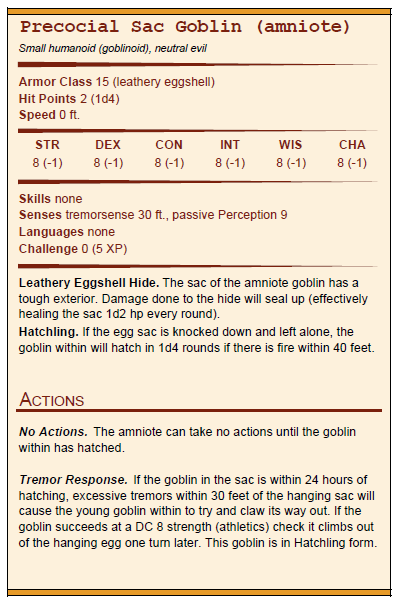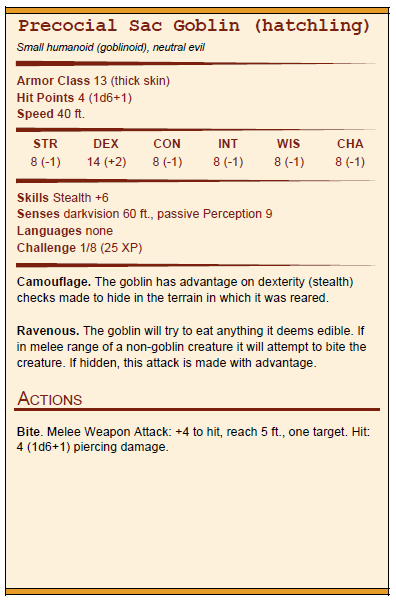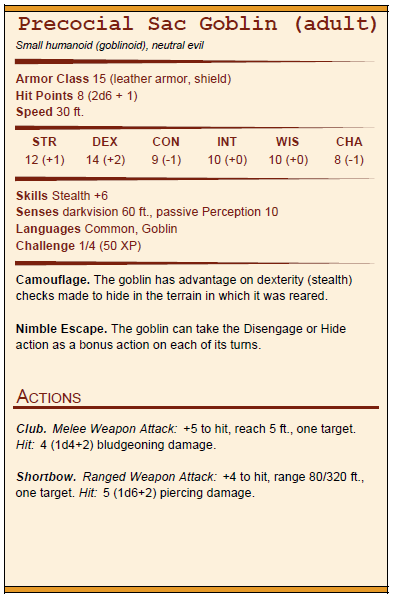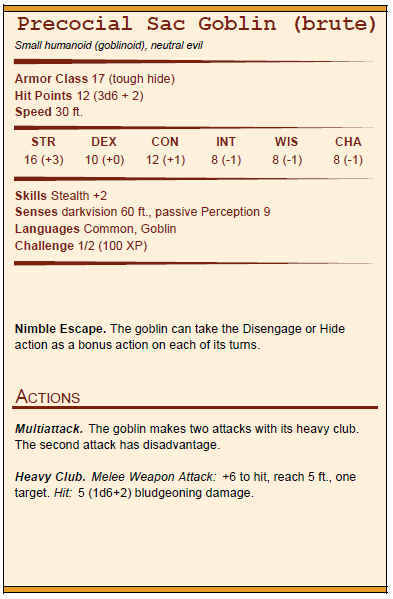I’ve recently started a new 5e D&D campaign, so I am looking forward to posting several times per month here on RPG Musings. It is a welcome change for me, and if you have followed this site for any length of time, I hope it will be a welcome change for you as well.
My new campaign takes place in a frontier region far from lands governed and protected by a king, local lord, or large knightly order. Of course, on the frontier there is danger of hordes! In the case of this campaign – goblin hordes!
Since goblins are the major enemy in the first 5 levels of the campaign, I decided that I wanted something a little bit different than your standard run-of-the-mill D&D goblin. I like the details provided in the Monster Manual and Volo’s Guide to Monsters, but I want to make a few changes.
Before I get to the stats, let me tell you a little bit about these creatures, which I have named Precocial Sac Goblins. These goblins lay fist-sized eggs which then grow to the size of a bowling ball (over 4 days) with a leathery, mostly translucent covering. At that stage, the covering, which is effectively an amniotic sac (hence the sac part of the name), must be hung from a tree, rocky outcropping, or other structure high enough that the sac hangs down to about 2-3 feet off the ground. It must then be incubated with fire at the right temperature until the young goblin inside claws its way out (after about 4 days). When it does so it is fully formed – hence the name precocial – and it is small and absolutely ravenous. In the two days it spends as a hatchling, it can eat its weight in food and grow to twice its size. At that point it is a fully grown goblin. The PCs walking into a small clearing with these sacs hanging from trees all around the perimeter and small nests of eggs at various places around the clearing gives a real Aliens vibe.
Lets talk about stats then…
The unhatched goblin is still incubating in its sac and offers little resistance and only a small amount of danger. Smart PCs will understand the danger of a failed attempt at cutting down and destroying these sacs, however, since it often triggers hatching! A hatchling, while fully formed and recognizable as a goblin, does not exhibit adult goblin behavior. Instead, these little buggers claw their way out of the sac and are ravenously hungry, eating almost anything they can get their hands on.
A hatchling, while fully formed and recognizable as a goblin, does not exhibit adult goblin behavior. Instead, these little buggers claw their way out of the sac and are ravenously hungry, eating almost anything they can get their hands on. The Precocial Sac Goblin has skin ranging from dark green to dusky grey to mottled beige – depending on what sort of environment they are in. To be clear, they are camouflaged because their skin exhibits cryptic coloration. This allows the goblins advantage on hiding and is reflected in the Camouflage trait.
The Precocial Sac Goblin has skin ranging from dark green to dusky grey to mottled beige – depending on what sort of environment they are in. To be clear, they are camouflaged because their skin exhibits cryptic coloration. This allows the goblins advantage on hiding and is reflected in the Camouflage trait. These adults typically have light tactical skills, climbing high up into the treetops and utilizing their bows to ambush prey. Scouts patrol Sac Goblin territory riding giant rats – the goblins and rats in combination give off the distinct smell of wet dog. Tactical prowess aside, these creatures are rather dim and do not understand even the basics of creating a high quality weapon… or perhaps they just don’t have the patience to sit and sharpen a knife or spear? As a result, foot soldiers in the tribe usually use primitive clubs and bows recovered from their victims. Occasionally (about one in every dozen) a sac goblin incubates for an extra day, producing a very large and very hungry hatchling which takes on the brute form 24 hours after hatching. It spends that day eating, eating, and more eating. This leads to a very strong (relative to the other sac goblins) brutish adult sac goblin with a thick hide and a thick skull.
These adults typically have light tactical skills, climbing high up into the treetops and utilizing their bows to ambush prey. Scouts patrol Sac Goblin territory riding giant rats – the goblins and rats in combination give off the distinct smell of wet dog. Tactical prowess aside, these creatures are rather dim and do not understand even the basics of creating a high quality weapon… or perhaps they just don’t have the patience to sit and sharpen a knife or spear? As a result, foot soldiers in the tribe usually use primitive clubs and bows recovered from their victims. Occasionally (about one in every dozen) a sac goblin incubates for an extra day, producing a very large and very hungry hatchling which takes on the brute form 24 hours after hatching. It spends that day eating, eating, and more eating. This leads to a very strong (relative to the other sac goblins) brutish adult sac goblin with a thick hide and a thick skull. The ability of the Precocial Sac Goblins to proliferate throughout their territory is dependent on the skill of the Matron. This is the goblin that ensures the correct hanging distance, tends the incubating fires, and nurtures the eggs until they reach the amniote stage. Often, the Matron has magical talent that is used to help the incubation process and ensure the survival of the tribe. A single Matron may bring forth 25 to 30 hatchlings per clearing, and it may tend up to 3 clearings per mating season. This is a highly valued position and the Matron is protected even better than the Chief or Boss.
The ability of the Precocial Sac Goblins to proliferate throughout their territory is dependent on the skill of the Matron. This is the goblin that ensures the correct hanging distance, tends the incubating fires, and nurtures the eggs until they reach the amniote stage. Often, the Matron has magical talent that is used to help the incubation process and ensure the survival of the tribe. A single Matron may bring forth 25 to 30 hatchlings per clearing, and it may tend up to 3 clearings per mating season. This is a highly valued position and the Matron is protected even better than the Chief or Boss.
It is important to note that these goblins do not submit to bugbears or hobgoblins. It’s not that they aren’t decrepit, sniveling, servile weaklings… it’s that they reproduce so rapidly and have learned to use their numbers as strength. It helps that hobgoblins have not yet infested the areas Sac Goblins currently occupy. Bugbears steer clear of Precocial Sac Goblin territory because they may find themselves overtaken and enslaved by a massive band of goblins.
So that’s my re-envisioning of the goblin. What do you think? Here is a downloadable PDF version of the above text and the stat blocks.
As Always, I wish you Good Gaming!
~DMSamuel

So, is it one matron per grouping (tribe?)? Are all goblins egg-layer or is it usual division of sexes? How often do they produce eggs?
Interesting take on goblin tough, I just have questions as is my nature.
Interesting Questions!
I was thinking about this shortly after I posted the article. I was envisioning one to four Matrons per tribe. Given the 25-30 sacs per clearing with 3 or so clearings per Matron, that means that a single tribe can produce a range of 300-360 goblins per mating bout**. I guess the question is how often do mating bouts occur? This will give a birth rate per tribe – I feel this is something that can change based on the tribe and various environmental factors. I am thinking that these little buggers are extremely fragile, but mate often… so I am thinking once or twice a month in the warm season with a possible mid-winter mating bout or two.
I was thinking of these creatures in a hive model – so the Queen will decide who to mate with and then produce eggs, which the Matrons take and care for, and which then hatch and become active members of the tribe. The Chief or Boss is the leader of the male goblins, but is only in charge of the males and is second in command, with the Queen being all powerful. The Matrons would be second in command of the female goblins.
Male goblins are more like worker drones and spend their time hunting, fighting, and guarding the territory. The females are split into three castes – one whose members are being primed for becoming a queen or matron, one whose members organize the tribe and communicate with other tribes, and one whose members perform the menial tasks around the territory (caring for animals, cleaning, taking inventory of the riches pilfered by the tribe, etc).
**the math there is (25 per clearing) * (3 clearings per Matron) * (4 Matrons) = 300 to (75 per clearing) * (3 clearings per Matron) * (4 Matrons) = 360
I think I need to write another article! :)
This is some good stuff! I can envision adapting them to different terrains, too. New human settlements coming into contact with these previously unknown goblin hoards should make for a great start to a campaign.